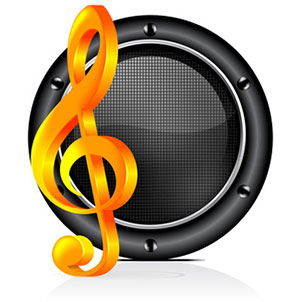 Your monitoring setup is super important if you are recording music. I would say that it is much less important for voice-over or video narration for a number of reasons, but primarily due to the fact that only your voice is being recorded, which is a pretty simple sound source at a predictable frequency that it doesn’t have to share.
Your monitoring setup is super important if you are recording music. I would say that it is much less important for voice-over or video narration for a number of reasons, but primarily due to the fact that only your voice is being recorded, which is a pretty simple sound source at a predictable frequency that it doesn’t have to share.
With music though, you have multiple sound sources with energy at multiple frequencies, many of which overlap. That means you have instruments (including vocals) often competing for the same frequency real estate. That can cause some sounds to be hidden or masked in a mix. But on top of all of that is the enormous problem of monitoring in a less-than-acoustically-ideal room. Hint: for those of use monitoring music in rectangular rooms, like bedrooms, our monitoring spaces are less-than-ideal by definition. Sound waves coming out of the speakers bounce off the walls and ceilings and collide with other waves. The parallel boundaries (walls, celings, floors) create areas where certain frequencies combine to sound much louder than they really are (yes, the room lies to you!), or do the opposite – make certain frequencies sound much softer than they really are. Sometimes in the latter situation, frequencies disappear altogether!
So imagine mixing in such a room. If bass frequencies are being hyped by the room, and certain middle frequencies are disappearing, you will turn the bass down and the middle frequencies up until they sound “right.” But then in a different space, or on an iPod, etc. suddenly the song has no bass at all, and the mids are ripping your sinuses out!
The solution to controlling a monitoring setup is a combination of knowing your mixing room and its tendencies, and doing as much acoustic treatment as you can do reduce the distorting effects of the room. You can also make sure you listen in different spaces to help you get to the “truth” of the mix and then compensate accordingly.
So let’s say you have gotten used to your room and maybe treated it as well. You know how to create a good, portable (meaning it will sound good anywhere it’s played). But suddenly you either have to move, or mix in an unfamiliar room or studio. That new room will sound strange to your ears. You need to be able to calibrate your ears to that new space.
Here is a great article telling you how to do that quickly by creating your own playlist of songs that you can use to test the acoustic aspects of the new room. They recommend 6-10 songs, each designed to test a different parameter like stereo imaging, dynamic range, 3D imaging, low frequency response, high frequency response, etc.
Read the full article here:
http://en.audiofanzine.com/getting-started/editorial/articles/how-to-control-a-monitoring-system.html
mixing
Tips For Mixing Using Musical Function Rather Than Individual Tracks
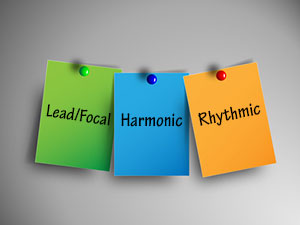 I just read a really good article on mixing music. The focus was different from what is normally talked about when mixing. Usually you hear things like pan the bass track, the kick drum track, and the lead vocal track, to the center of the mix. The pan the other tracks out from there to create stereo. Add this kind of EQ, compression, reverb, etc. to that kind of track, and on and on. But the article I mentioned talked mainly about “groups” rather than tracks.
I just read a really good article on mixing music. The focus was different from what is normally talked about when mixing. Usually you hear things like pan the bass track, the kick drum track, and the lead vocal track, to the center of the mix. The pan the other tracks out from there to create stereo. Add this kind of EQ, compression, reverb, etc. to that kind of track, and on and on. But the article I mentioned talked mainly about “groups” rather than tracks.
For example, the author, Rob Schlette, defines 3 groups: the lead/focal content group, the rhythmic content group, and the harmonic content group. The article even contains a cool graphic showing what instrument is on what track, and color-coding the groups. BTW, “BGV” means “background vocals,” which took me a couple of minutes to figure out:).
Then using tone as defined by the above groups, you can organize your mix in a certain way – by creating contrast between the groups (using tools like EQ, compression, and even saturation effects – to help the tones perform their roles better. The article doesn’t explicitly say that you can best do this by creating subgroups of tracks, called “folders” in Reaper, BTW, that correspond to the 3 tonal groups. See our article Creating Subgroups In Reaper and Pro Tools for a review of subgroups. But it is surely the best way to go about doing this.
The article also suggests that this kind of mixing is great for giving an entire album a more cohesive feel to it.
To read the full article, follow this link: http://theproaudiofiles.com/mixing-with-mastering-in-mind-tone/
Can Award-Winning Recordings Be Made In A Home Recording Studio?
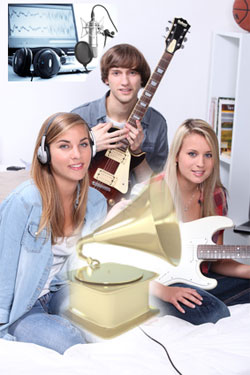 I just read an article entitled “Can Award-Winning Recordings Be Made In A Home Studio?” But before I even read a word of the article, I had my hackles up (a thing my wife says when something gets her quickly in “defensive-mode”). That’s because the title alone made me say “what do you mean by “home studio,” and what awards are you talking about? We (my wife, Lisa Theriot and I) were finalists for an award called a “Voicey Award,” bestowed by Voices.com for voice-over recordings. So based on that, I’d say “of course” to the question posed in the title. We recorded our audio in a home studio, as did the eventual winner of our category.
I just read an article entitled “Can Award-Winning Recordings Be Made In A Home Studio?” But before I even read a word of the article, I had my hackles up (a thing my wife says when something gets her quickly in “defensive-mode”). That’s because the title alone made me say “what do you mean by “home studio,” and what awards are you talking about? We (my wife, Lisa Theriot and I) were finalists for an award called a “Voicey Award,” bestowed by Voices.com for voice-over recordings. So based on that, I’d say “of course” to the question posed in the title. We recorded our audio in a home studio, as did the eventual winner of our category.
The other thing that got me a bit rankled is that I generally despise the idea of awards for media productions. We make recordings for various reasons but few of us are out to “win an award.” Heck, most folks I talk to would be really happy if they could just get their audio to sound more professional. Who cares about an award? And my last word on awards and home studios is to point out how many major non-home studio recordings there are that have not won awards.
OK. Now that I’ve got that out of my system, let talk about the article.
First, the author, Bob Buontempo, specifies what he means by “award” (or at least level of award) when he says “i.e. – Grammy.” He’s talking specifically about music and not spoken-word/voice-over work. And he’s talking really prestigious, world-stage awards. That narrows things down a bit.
Next, he suggests that his definition of a home studio is “everything is in the spare bedroom,” because he states that it would be improbable to win a Grammy because you can’t fit a whole band (and that’s debatable) or an entire orchestra into a bedroom. Well, when you so narrowly define “home studio,” you make it much less likely for a recording made that way to be capable of winning a Grammy.
However, as the article goes on, there are suggestions that under the right circumstances, it is absolutely possible for a home studio recording to achieve Grammy caliber. It mostly comes down to the performance and the song. After that, it comes down to the knowledge of the engineer.
Yes, it is a fact that a large commercial recording studio is going to have more gear options, and that gear is likely to cost a LOT more than the typical home studio is likely to ever be able to afford. Also it is a fact that most recording and listening spaces in large commercial studios will have superior acoustics, which makes for more accurate mixing and better mastering.
Oh, yeah – the mastering thing. The author did not specify whether a home recording that is sent to a professional mastering facility counts as “a recording made in a home studio.” It should. Even the big studios send mixes to separate mastering facilities.
And this, for me, is the elephant in the room. Take 100 people off the street. Heck, even make them music loving people. Then ask them to listen and tell you the difference between a 24-bit/192KHz recording and a 16-bit/44.1KHz recording, and I would wager they could not tell you. I’d even be willing to bet most of them could not say which was an mp3 if you threw that into the mix! The purist may argue that the difference would be noticeable when played on a super high-end audio system. Maybe. But then what percentage of the music-consuming public are listening to high-definition music on high-end systems. A very tiny fraction.
So though on paper, the audio created in a home recording studio cannot, by the specs, go head-to-head with the major studio recordings, at the end of the day I say “so what?” People listening to music don’t look at specs. They listen to music. And the specs mean nothing if the recordings sound good. And recordings made in home studios are perfectly capable of sounding good.
Now for my final take on this question – do most recordings that people make in their home studios sound as good as the pros? In my experience they absolutely do not. That is because the gear is so affordable and anyone can get it now. That means there are thousands of people making home recordings with gear they don’t know how to use. I’ve said this many times – people with no audio knowledge, but with a million dollars worth of equipment can (and usually do) make crappy recordings if they know what they are doing. However, someone who DOES know what they are doing can make awesomely professional sounding recordings with a few hundred dollars worth of gear. It’s about the knowledge. One other thing I also say is that you can get that knowledge on Home Brew Audio. We make the daunting techno-jargon easy to understand so you can make great – even award-winning audio – in your home studio.
Cheers!
Ken
BTW, the original article is here: http://www.prosoundweb.com/article/can_grammy_winning_recordings_be_made_in_a_home_studio/
Mixing Music: The Art And the Science
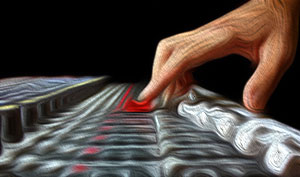 I just read a fantastic article by Recording Magazine called The Art and Science of the Mix: Methods and Approaches to Mixing. It does focus on music mixing – so for the voice-over-centric readers, it may or may not be of as much interest to you. But if you do any music mixing, this article rocks!
I just read a fantastic article by Recording Magazine called The Art and Science of the Mix: Methods and Approaches to Mixing. It does focus on music mixing – so for the voice-over-centric readers, it may or may not be of as much interest to you. But if you do any music mixing, this article rocks!
Obviously it reminds us that mixing music is a combination of art and science. But from my point of view, the science – or put another way, the methods and reasons for those methods – come first. Otherwise we wouldn’t have as many brushes and paints and palettes and easels (OK, you see I’m running with the “art” metaphor here:)) to create the art we envision.
Fortunately the author, Bruce Kaphan, gives plenty of useful concrete tips to create better mixes, such as his typical pan settings for drum kits and other instruments, how he begins a mixing session, etc.
One other thing that comes through in the article is the presupposition that there will be three distinct people involved in a music recording project: the person recording and preparing the tracks (recording engineer), the person mixing the project (the mix engineer), and the person mastering the project (the mastering engineer). See our post
Recording Engineer, Mix Engineer and Mastering Engineer – Oh My for more information on what the heck I mean by all that.
Anyway, do yourself a favor if you mix music and get thee to this article, which you can read in its entirety here: http://www.recordingmag.com/resources/resourceDetail/122.html
Mixing Contest by PureMix
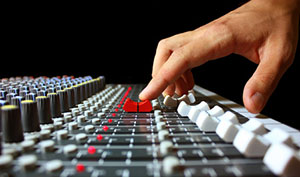 Mixing contest alert! PureMix is a site with audio recording, mixing and processing tutorial videos that make it sort of feel like you are working as a learning assistant to a professional studio engineer. Pretty cool stuff. You can check them out here: http://www.puremix.net/about-us.html.
Mixing contest alert! PureMix is a site with audio recording, mixing and processing tutorial videos that make it sort of feel like you are working as a learning assistant to a professional studio engineer. Pretty cool stuff. You can check them out here: http://www.puremix.net/about-us.html.
This month and next (April and May 2013), in association with Sweetwater Pro Audio and Dangerous Music (makers of high-end audio gear), are doing something very cool and fun. They are holding a massive mixing contest! How would something like that work? Well, they provide some audio files and you mix them together and render your version. In this case, they are providing tracks from singer, Liza Colby Sound’s song “Oh Baby.” Then you have until June 1st to create your own mix of the song using the files you downloaded. Sounds like a blast!
The rule is that you cannot change the arrangement. In other words, you cannot add other instruments or sounds. Your job will be to put use just panning, volume and effects to blend/mix everything together, then mix it down (see our article What Does It Mean to Mix Down Audio?) to one audio file and upload it to your SoundCloud account (it’s free) and then submit your masterpiece by June 1st, 2013.
Sweetwater, online retailers of recording and musical gear and one of the sponsors of this contest, will be announcing the winners of the contest during their annual GearFest event on June 21st and 22nd.
There will be 16 top candidates announced on June 21st, who will all be awarded prizes ranging from $3,990 (pair of Focal Twin6 Be speakers) for first prize, all the way down to a $269 value for a one-year subscription to PureMix. In between are various microphones and other audio goodness. You’ll get a list as soon as you sign up.
I already entered, downloaded my files and loaded them up in my DAW (“digital audio workstation” – another way of saying “multi-track recording software”) of choice – Reaper. Of course you can use whatever DAW you wish, or you could do it the old fashioned way and use analog tape if you have the gear for it.
What are you waiting for? Go sign up here: http://www.puremix.net/gearfestmixingcontest